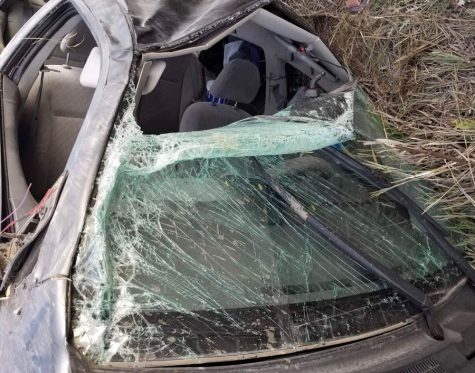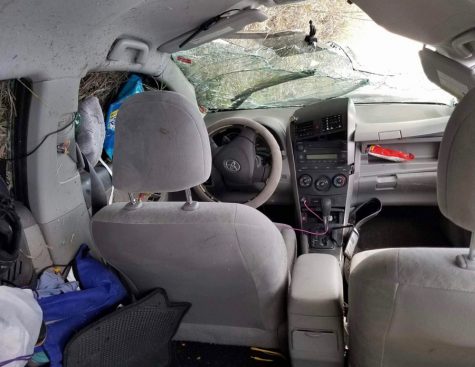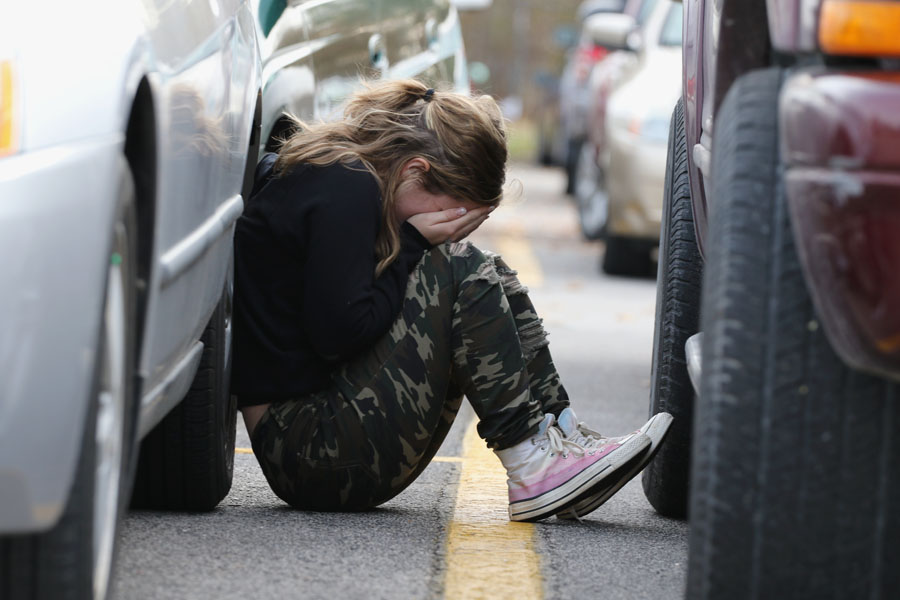Your donation will support the student journalists of West High School. Your contribution will allow us to purchase Scholarship Yearbooks, newsroom equipment and cover our annual website hosting costs.
From invincible to helpless
At the beginning of the song, Taylor Gardner ’19 thought she was invincible; by the time the song finished the chorus, she learned that she wasn’t.
November 17, 2018
Glistening rays of sunlight beamed down to Naples Ave. where a grey 2009 Toyota Corolla was about to flip and change the course of senior Taylor Gardner’s life.
It all started with a volleyball tournament back in September last year. Gardner was keeping score and judging the game. Feeling down after hearing recent gossip, she had called her friend, Maggie Pfannebecker ’19 to keep her company. The two decided to go to the mall. At around 3:30 p.m. on Saturday, Sept. 16, 2017, Gardner picked up Pfannebecker who lives on a farm off a gravel road.
Gardner, 15 at the time, drove on the gravel road going around 45 to 50 miles per hour, below the speed limit of 55; her windows were down with music blasting through the speakers. The girls had no idea what was about to unfold before them. Just as Rihanna was about to sing the first chorus of “S&M,” the back wheels of the car lost their grip on the road, and seconds later the front wheels did too. With no traction to the ground, Gardner knew at that point she was going to end up in the ditch.
The grey 2009 Toyota Corolla skidded left towards the center of the road. Gardner broke and swung the wheel towards the right side of the road. First, the passenger’s side hit the ground. Then the roof. Finally the driver’s side. As the car flipped, Rihanna sang the chorus.
“A lot of people say, ‘Your life flashes before [your] eyes.’ My life didn’t flash before my eyes,” Gardner said. “It wasn’t like slow motion, but it wasn’t like I couldn’t think; I knew what was going on.”
Landing on the driver’s side the vehicle landed in the ditch and Rihanna’s voice could no longer be heard.
“I immediately made sure Maggie was okay because that was my main concern while the car was flipping, I was like, ‘Oh my gosh, Maggie,’ because I could handle myself getting hurt,” Gardner said. “But I couldn’t handle if I hurt someone else severely.”

The grey 2009 Toyota Corolla stayed in the ditch for a day. Gardner’s mother snapped one last photo before it got towed away.
After looking for a way out of the car and searching for her phone to call for help, Gardner turned her attention to Pfannebecker.
“Maggie was conscious. She was fine. She had like a huge bump on her head that I was really worried about,” Gardner said.
Pfannebecker was sitting in the passenger seat of the car, meaning that she now hung in the air with her only support being the seatbelt. “I unbuckled Maggie, she was scared because she thought she was gonna fall because she was up … there was nothing underneath her to grab her, so I made sure I caught her,” Gardner said.
The two friends then proceeded to climb out of the shattered back window and dialed 911. “I told them exactly how old I was. I told them what happened. I didn’t hide that I was 15 [and] I [didn’t] have a license,” Gardner said.
In the state of Iowa, teens are permitted to get a minor school license starting at 14 and a half, allowing them to drive to school or school-sponsored activities.
“I knew it would be better for me to be honest, because they would find out anyway,” Gardner said.
When the ambulance and the law enforcement arrived at the scene, Gardner demanded that the paramedics see to the bump on Pfannebecker’s head, “When I was talking to the police, all of a sudden I got a really sharp pain in my neck,” Gardner said.
The paramedics turned their attention to Gardner. At the slightest pressure applied to the area around her neck, an eruption of pain would come with it.

A day after the accident, Gardner’s mother returned to the scene to document what happened.
Police officers spoke to Gardner’s mother over the phone because she hadn’t arrived at the scene yet, explaining that Gardner was having a sharp pain in her neck and it could be serious. Gardner was then taken to the hospital where she would spend the next two and a half days being monitored and having tests done in hopes of finding the cause of her pain.
“My legs weren’t responding to what they were supposed to … Doctors were coming in every two hours. I got no sleep. I wasn’t allowed to eat or drink anything. I had to lay completely still on my back,” said Gardner. “Finally, they told me that I damaged a bunch of ligaments and muscles that are all in my neck and my spine that connect to my bones.”
Recovery
Pfannebecker stayed a night in the hospital and left the next day with a few bruises. That wasn’t the case for Gardner. For the next six months, three days each week, Gardner went to physical therapy (PT), which is a form of rehabilitation performed to restore a patient’s function, normal movement and reduce pain. Gardner was first treated for pain in her neck and soon after was also treated for her spine.
“In a clinic situation PTs could be helping restore normal motion and strength after a shoulder injury and even a surgical repair,” wrote physical therapist (PT) Joy Miller, who did not treat Gardner, in an email. “It is not just as simple as giving exercises and helping regain strength in a weakened joint.”
For the first two months, Gardner’s neck was completely immobile, but as her neck regained mobility the physical therapists found that there was more to Gardner’s injury then they had originally thought.
“At first, they thought it was just the ligaments in the muscles that connect to my neck. That’s when they found out I also damaged them to my spine,” Gardner said.
A ligament is a tough connective tissue that connects two bones together to support a joint.
“The neck is very mobile so it has many different joints throughout,” Miller said. “Injuries of the neck can be catastrophic. If an injury effects many ligaments, it can make the spine unstable and the spinal cord can be damaged and even severed, leading to paralysis.”
Though the accident happened more than a year ago, Gardner still some days wakes up in pain. The pain is usually in her back and neck, sometimes last the entire day. At times, the pain can be so overbearing that Gardner takes prescribed painkillers.
“Some days are worse than others. My back pain, my doctor said it could last forever. That’s something that they can’t tell,” Gardner said.
With some minor injuries, it can take four to six weeks of recovery; however, with more advanced injuries, especially those involving the spinal cord, it could take months or years for full recovery. Even with that, there is still a risk that her condition will not improve.
With the accident damaging the ligaments in her neck and spine, the life that Gardner had and future she envisioned for herself was changed.
For Gardner, it didn’t matter if she was good at sports or not, she loved being on a team and playing. However, after the accident, the doctors told her that sports and being the active person that she was weren’t in her near future. Instead of gyms, teams, games, and sports, Gardner was in a neck brace all day, every day, and that was the most frustrating part of recovery for her.
“It was really frustrating when I found out I wasn’t going to be able to do sports, and it was really frustrating when I wasn’t able to work out,” Gardner said. “I got frustrated all the time. Because I had to have someone carry my stuff and I just felt like I was helpless.”
The feeling of being helpless went on for months until finally, in early spring of this year, Gardner was able to do something that most high schoolers take for granted.
“When I started carrying my bag it really hurt,” Gardner said. “When I started to feel a little bit normal was when it stopped hurting as much and when I didn’t go throughout the day crying because I will admit when I started carrying my backpack I did cry a couple times because it hurt, but when I could go throughout the day without crying, that’s when I probably felt my most genuine self. I didn’t feel so helpless … I could carry my own backpack. I could do things that I want to do and I could do things for me instead of other people doing them for me.”
The science behind the accident
While the grey 2009 Toyota Corolla was jerking back and forth, Gardner had been trying to regain control.
She pushed as hard as she could down on the brakes, however, braking too suddenly can cause the wheels to lock, which in turn makes the skid worse. Not knowing this at the time, Gardner braked abruptly and overcorrected the steering wheel.
“All the sudden I lost control. I tried to gain it back, and it ended up flipping my car, because if you try to correct yourself while on gravel, it flips the car,” Gardner said. “And as instinct, I tried to correct it.”
Overcorrection is when a driver tries to fix what is happening by abruptly turning the steering wheel the opposite direction from where the car is going. Instead, drivers should lightly apply their breaks and slowly start moving the steering wheel to the direction they wish to go.
Infographic by Sidney Kiersch
More than a year later
At a time before a fear of gravel roads was in her mind and “S&M” was playing on her radio, Gardner had once been invincible, but one car accident, one chorus, had changed that.
“It changed me [and] how I perceive life. Every teenager goes through that phase where all they talk about is they want to die,” Gardner said. “My doctors told me that I’m lucky I walked out of there because most people don’t … and being that close to death made me realize how much I actually want to live.”
The accident had damaged the ligaments in her neck and spine but had also given Gardner a new outlook on life.
“I did one thing a day that scares me. I [feel] like life is too short to be scared of stuff,” Gardner said.
The first thing that Gardner did that scared her was to tell her story of what happened.
“At first, I just didn’t want to talk about it. I wanted to pretend like it didn’t happen,” Gardner said.
But when Gardner’s journalism class had been assigned to do an ‘all about me’ project Gardner had done hers about the accident. She had based the project about her life before and after the accident.
Other things that Gardner did that scared her ranged on a scale of going up to someone that she wouldn’t usually talk to and start a conversation to going back to the accident site. A little over two months after the accident Gardner and her mother had gone back to the scene of the accident. Gardner recalled she had been more astonished and out of breath than sad when she had gone back.
“It was very moving,” Gardner said. “It was really overwhelming … It wasn’t like reliving it because you can never possibly relive that kind of adrenaline and pain and everything going on at once. There’s no reliving that. But it was like everything flooded back more and how it happened, what I said, what exactly happened. Like I could follow my own footsteps. I know how I got out of the car where I got out of the car.”
Gardner went back to the place where her grey 2009 Toyota Corolla had flipped with WSS to tell and show her story, but as of now, she has no plans on returning. However, Gardner says that one day in the future when she has children she plans on taking them there.
“I probably will like one day. Like when I’m with my daughter or my son and I’m teaching them how to drive. And I’m telling them, ‘Look, this right here is where I crashed my car’ and showing them what could happen,” Gardner said. “I don’t really have a reason. It’s not something like I’m holding on to. It’s not something that like I’m trying to like, let go of. If it were [then] I would go back so I could try to make peace of what happened there, but I don’t have a reason to right now.”
Gardner is now back to working and going to the gym and she’s even planning on graduating early. Though she’s moving on, she hasn’t forgotten about the accident and more importantly what it has taught her.
“It taught me that I’m not invincible and I need to be careful when doing anything,” Gardner said. “I tell other kids this too, I know a couple people who right now just have their school permits but like to drive around. I tell them [to] be careful. I’m not going to tell you not to do it, and I’m not going to rat you out either. But be careful because I thought I was invincible. I thought nothing like a car accident would happen to me. Even though everyone warned me—my parents, everyone. They’re like, ‘You better be careful because stuff happens,’ and I always thought, ‘What are the likely chance of it happening to me?’”
With a little more than a year later Gardner still hasn’t fully recovered, however, she believes that she has moved on and let go of the accident.
“I’ve definitely made peace. It’s not something I’m angry about,” Gardner said. “I wish my back didn’t hurt a lot. I wish my neck didn’t hurt a lot, but the way it changed me spiritually was in such a positive way that I’ve made peace with it. And I’m okay with it. If I could go back, I wouldn’t.”


